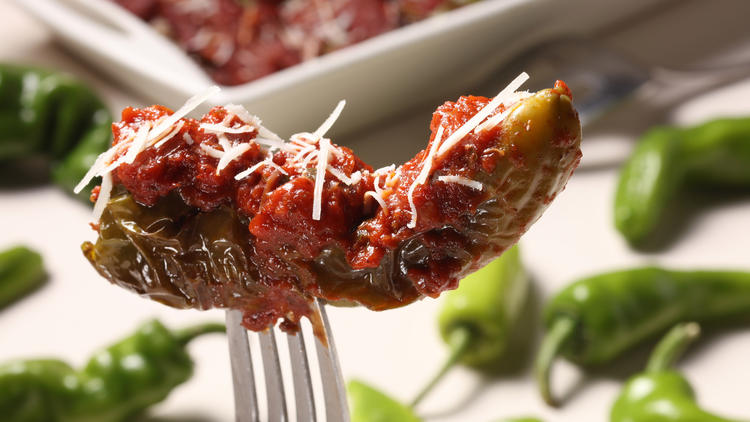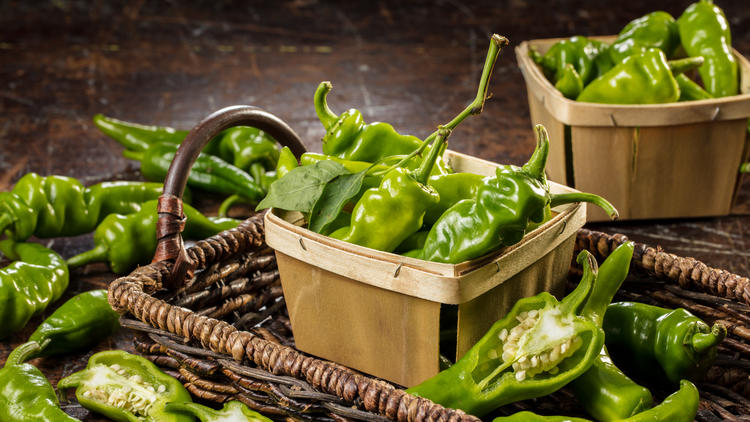Original link:
http://www.chicagotribune.com/dining/recipes/ct-melrose-peppers-food-0816-20170810-story.html
Food & Dining / Recipes
The story of the Melrose pepper,
a sweet vegetable found only in Chicago

Stuffed Melrose peppers feature Italian sausage,
ground round, pecorino Romano and a homemade marinara sauce. (Food styling by
Mark Graham.)
(Abel Uribe / Chicago Tribune)
By
Amy Bizzarri
Chicago Tribune
AUGUST 14, 2017, 12:08 PM
When Joseph and
Lucia Napolitano emigrated from southern Italy to America in 1903, they packed
their Ellis Island-bound, wooden trunk with their cherished belongings,
including their most prized possession of all: precious seeds that would produce
the fruits and vegetables needed to feed their growing family — eventually 15
children in all — and establish their slice of the American dream.
Farmers in Italy, the Napolitanos had escaped a crushing rural economy, where
civil and economic unrest as well as soil depletion left many southern Italian
families with no other choice but to emigrate. They ended up in suburban
Chicago, where a handful of the seeds they brought, gathered from pepper plants
that once grew wild in the volcanic earth of Nocera Inferiore (a small town
about 12 miles southeast of Naples), found success in the rich soil of Melrose
Park.
Delectable, tender and sweet, and named after their new American
hometown, Melrose peppers have come to be among the most beloved fruits of the
local Italian-American backyard garden. Each pepper is about 4 to 6 inches long,
with thin skin and, despite the resemblance to hot chiles, zero heat. When
harvested young and green, a Melrose pepper tastes like a super-sweet, green
bell pepper; when fully ripe and brilliant red, these beauties are all the
sweeter and richer.
Italians, mainly from the southern end of the boot,
began settling Melrose Park in the early 1900s, attracted by well-paying
industrial jobs and large tracts of fertile farmland. Small, family-run farms
nicknamed "pepper patches" sprouted up along North Avenue, from Mannheim Road to
Fifth Avenue, according to "Melrose Park: 100 Years of Progress," a book
published in 1982 to celebrate the suburb's centennial. Joseph and Lucia built
their pepper patch on land in what is today the Winston Park subdivision of
Melrose Park, at Ninth and North avenues.
The Napolitanos' firstborn son,
Tom, grew up working beside mom and dad in the fields, changed his last name to
the easier-to-pronounce Naples and began selling the fruits of the family farm
at a fruit and vegetable stand on North Avenue in Melrose Park, says his
grandson, Tom Naples Jr. From the mid-1920s to the late-'80s, Tom Naples
Homegrown Vegetables and Fruit was best known for its fine selection of seeds,
flowers and plants in the springtime, painted pumpkins in the fall, Christmas
trees in the winter, and a variety of produce available year-round. In the late
summer, Melrose peppers sold out almost as fast as they hit the stand.
Naples Jr. recalls working beside his grandfather in the field.
"Grandpa
Tom would carefully examine the Melrose pepper crop, taking the plants with the
biggest and best buds and moving them to a separate row, at the edge of the
field. He gifted the peppers harvested from those select, hardy plants, to local
ladies, for free; in return, the ladies would string and dry the peppers for use
throughout the year in their kitchens, making sure to reserve the seeds for
Grandpa Tom, who guaranteed a bushel from the next year's harvest. We also sold
the Melrose pepper plants themselves, first wrapped in newspaper, then in wooden
and then plastic flats."
Italian-American Melrose Parkers were known for
tending their own, abundant backyard gardens filled with zucchini, tomatoes,
peppers — all the fruits and vegetables that reminded them of home. Despite the
conversion of area farmland into retail and residential neighborhoods in the
1950s, backyard gardens continued to thrive among the Melrose Park
Italian-American community.
Melrose Park-born Mike Quagliata fondly
remembers the bountiful Melrose Park garden that belonged to his grandfather,
Mario Quagliata.
"When I was a kid in the later '50s and early '60s, just
about everybody I knew had a vegetable garden in their backyard," Quagliata
says. "Grandpa loved to work in his garden. He especially liked opportunities to
walk people through his garden, to show off what he was growing. He grew all
kinds of vegetables, but he loved Melrose peppers the most of all."
Come
spring, Mario Quagliata would start growing the peppers indoors, basked in
natural light from a window, Mike Quagliata says. In May, he moved them to a
makeshift greenhouse outside his garage, made from a cement block enclosure with
an old storm window acting as a roof.
"Later, in May, he would set the
little pepper plants in his garden," Quagliata says. "Mario's wife, my grandma
Josephine, cooked up great meals with the garden harvest. It was so much fun for
the extended family to get together at Mario and Josephine's house for dinner,
with the closeness of the family and the fantastic aroma of grandma's cooking."
You'll find the peppers themselves only in the Chicago area, in the late
summertime, at farmers markets or area Italian-American grocers, notably Angelo
Caputo's Fresh Market in suburban Elmwood Park, which stocks the highly
anticipated peppers in late August. They are sometimes also found at select
Mariano's stores, but call first to check.
"Word spreads quickly when the
Melrose peppers become available, and the feasts begin … along with the debates
over whose recipe is best," says Sam Fantauzzo, vice president of development
for Angelo Caputo's Fresh Markets. "No matter how they're prepared, they offer a
unique, mild, tender, sweet pepper flavor that, as it sizzles in a pan of garlic
and olive oil, creates an aroma that's both distinctive and immediately
recognized."
Melrose peppers have inspired many dishes. They can be fried
into cruschi, crispy, potato-chip-like delicacies; blended into a creamy pasta
sauce served with penne rigate; or baked according to the Naples family's
traditional stuffed-peppers recipe.
Delia Abruzzo of Abruzzo's restaurant
in Melrose Park prepares traditional cruschi, sun dried and fried peppers, by
stringing the peppers and hanging them outside to dry for 20-25 days during the
remainder of the summer months, then deep-frying them in olive oil. "They have
the texture of a chip and taste sweet yet slightly spicy," says Abruzzo.
"Crumble the cruschi over scrambled eggs, serve as a topping for polenta, add to
your favorite pasta sauce for an extra kick, or serve as is."
Melrose
peppers are also sublime in their simplest form: sauteed in garlic and olive oil
and served with a loaf of crusty Italian bread.
Amy Bizzarri is a freelance writer.

When harvested young and green, a Melrose pepper
tastes like a super-sweet, green bell pepper. (Food styling by Joan Moravek.)
(Zbigniew Bzdak/Chicago Tribune)
Cruschi (sun-dried and fried
Melrose peppers)
Prep: 25 minutes
Cook: 3 minutes
Makes: 4 servings
Southern Italy has a centuries-old tradition of preserving peppers via sun
drying, so they can be enjoyed even in the cold winter months. I recommend
serving the crispy peppers as an accompaniment to a glass of one of Campania's
two DOCG-certified white wines, Greco di Tufo or Fiano di Avellino. (This recipe
was not tested by the Tribune.)
8 Melrose peppers, ripened to red
1
quart olive oil
Sea salt
1. Rinse the Melrose peppers, and pat dry.
Remove the seeds and stems, and cut into pieces.
2. Place the cut peppers
on a baking sheet, and set in the sunlight every day until dried. To speed up
the process, you can also place in a 200-degree oven for 2-3 hours until dry.
Store in a cool, dry space until you are ready to deep-fry.
3. In a deep
skillet, heat the olive oil to 350 degrees.
4. Fry the peppers in the hot
oil, in small batches, until the skin turns a slightly darker red, about 3
minutes.
5. Remove and drain on paper towels, and sprinkle with sea salt.
Eat immediately, or store in an airtight container to retain crunchiness.
Penne with creamy roasted Melrose pepper sauce
Prep: 20
minutes
Cook: 15 minutes
Makes: 4-6 servings
If the peppers are
large, cut back to just four peppers.
8 Melrose peppers, ripened to red
2
tablespoons olive oil
2 cloves garlic, finely chopped
1/2 teaspoon salt
Freshly ground black pepper
1 cup heavy cream
1/2 cup grated pecorino
Romano
1 pound penne rigate
1. Roast the peppers: Rinse the peppers,
and pat dry. Place the peppers on a rimmed baking sheet. Slide under a hot
broiler on the top rack. Roast until black spots appear; turn the peppers.
Continue to roast and turn until all sides are blackened. Let cool, pull off
blackened skins and remove ribs, seeds and stems. Coarsely chop peppers.
2. Heat a large skillet over medium; add the oil. Saute the garlic until golden
brown and soft, about 1 minute. Add the peppers and stir. Season with a generous
pinch of salt and pepper.
3. Transfer pepper-garlic mixture to a blender;
puree. Return puree to skillet; heat to a boil over medium. Stir in the cream
and the cheese. Simmer over low heat, 5 minutes.
4. Meanwhile, cook penne
in a large pot of well-salted boiling water until al dente. Drain and add the
penne to the skillet, stirring and cooking over low heat, 3 minutes.
Stuffed Melrose peppers
Prep: 2 hours
Cook: 2 hours
Makes: 4-6
servings
Every family in Melrose Park seems to have their own unique way
of stuffing and baking Melrose peppers. Some pack the peppers with ’nduja, a
spicy, Calabrese pork sausage; others top the stuffed peppers with a generous
heaping of shredded mozzarella, provolone or Scamorza cheese, before baking. The
Naples family of North Avenue fruit and veggie stand fame keeps it simple by
filling the late-summer peppers with a combination of Italian sausage, ground
round and pecorino Romano, drenching them in an easy, homemade marinara; then
roasting them in the oven to bring out their natural sweetness.
2 pounds
green Melrose peppers
Stuffing:
1 cup white rice (not instant)
1
pound ground round
1/2 pound Italian sausage, removed from casing
1/2 cup
pecorino Romano, grated
1 teaspoon salt
1 teaspoon pepper
2 tablespoons
finely chopped flat-leaf Italian parsley
2 cloves garlic, finely chopped
3
eggs
1/2 cup olive oil
Sauce:
1 large onion, diced
2 cloves
garlic, minced
1 can (28 ounces) crushed tomatoes
Salt and pepper
4
leaves fresh basil, finely chopped
2 teaspoons finely chopped flat-leaf
Italian parsley
1. Heat the rice, 2 cups water and 1/2 teaspoon salt to a
boil in a small saucepan. Cover and lower heat to a simmer. Simmer until rice is
done, about 20 minutes. Spread rice on a baking sheet to cool. When cool, mix
the rice in a bowl with the remaining stuffing ingredients, except the oil.
2. Wipe the peppers with a damp paper towel. Cut out the stem and remove the
seeds. Fill each pepper to the top with the shuffling (We used a pastry bag to
pipe in the mixture.) Heat 2 tablespoons olive oil in a skillet over medium-high
heat. Cook the stuffed peppers, in batches, and turning as you go, until brown
on all sides, about 4 minutes per side. Place in one or two roasting pans,
preferably in one layer. Repeat with remaining peppers, using more oil as
needed. Set aside and prep sauce.
3. For the sauce, in the skillet used
for frying peppers, cook the onion until translucent, about 4 minutes. Add the
garlic; cook until golden, about 1 minute. Add tomatoes; season with salt and
pepper. Simmer on low heat, 30 minutes. Stir in basil and parsley.
4.
Pour sauce over peppers; bake in a 350-degree oven until peppers are soft and
filling is cooked through, about 40 minutes.
Copyright © 2017, Chicago Tribune
Dining and
Drinking Recipes

